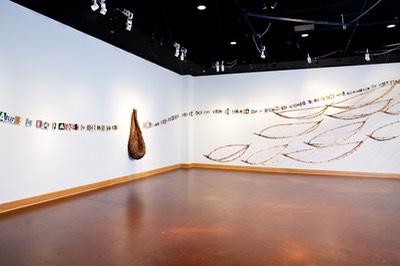
Heather Carter: Sustainability through Art
Trees have always played a prominent role in the artwork of Wimberley, Texas, artist Heather Carter. She particularly likes the consistency and texture of the pine and poplar species and frequently turns to them to construct the frameworks for the ribcage and boat hull forms that make up the main body of her sculptural work. For Carter, the bent wooden forms that she creates from these trees as well as the series of shadows that they in turn cast on the wall are rich with metaphorical associations that range from the corporeal and architectural to the spiritual and supple.
The Selection Panel and Advisors for the Austin Art in Public Places project also found these bent wooden forms particularly compelling, and in 2003, they selected Carter to design an artwork for the new reading room of the Spicewood Springs Library in Austin, Texas. For this project, Carter again turned to the medium of wood as well to the same bent forms that had informed her previous studio work. Yet, whereas in her earlier work, the wood functioned largely in a structural and symbolic manner, for this installation, Carter greatly expanded these associations so that the wood now also served an ecological purpose.
For this commission, Carter worked alongside architects from the Austin, Texas, architectural firm TeamHaas to design a work that would complement their 6,000 square foot addition to this northwest Austin branch library. Carter’s design, which she created to extend across the 55 foot long reading room addition, offers a dynamic counterpart to the largely glass and metal framework that makes up this room. Entitled Souls of the Trees, the work consists of eleven separate bent wooden sculptural pieces which she installed in 2007 onto the maple plywood veneer above the reading room’s expansive window lined wall. The organic shapes of these wooden forms, which again allude to ribcages and boat hulls, provide a rich and energetic counterpoint to the rigid geometry of the glass and metal. This dynamism is reiterated by the whimsical shadows cast by each of the wooden sculptural forms that change not only according to one’s position and the lighting of the room but also according to the ever changing sunlight that filters through the glass windows.
Sunlight is not the only connection that Carter’s installation shares with the natural world. The wooden forms of her sculptures also actively engage with the large oak trees that the architects worked carefully around in their design for the addition. For Carter, however, the resonance between her work and the living trees outside is more than happenstance; it represents an intrinsic part of the overall meaning of her art as well as her life. This is because, like the solar house in which she lives with her family off the grid, she created this installation as a carbon-neutral work. After calculating the amount of carbon that was emitted from both the creation of this installation and its projected maintenance over time, Carter had three trees planted outside the library to absorb this carbon dioxide. In so doing, Carter demonstrates the life supporting function that trees play in the world and her art, while at the same time she also encourages the community to think about the ways that they might live more sustainably. It is precisely this effort to engage with trees on such a multitude of levels—aesthetically, metaphorically, spiritually, ecologically—that makes Carter’s Souls of the Trees such a dynamic and evocative work of art.
Erina Duganne, PhD
Associate Professor, Texas State University






